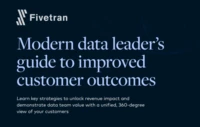HOW TO THRIVE IN THE AGE OF INFINITE DATA
This book will demonstrate the usefulness of data integration to your organization, explain and evaluate the various approaches to data integration currently available, and show you how to implement the technology. You don’t need to read it front to back, although it is organized to be digested easily that way. Data integration consists of the processes used to manage and centralize flows of data from various sources, in order to use that data to guide decision-making. The practical interpretation of data to guide decisions is often referred to as analytics.
As we will see, the quality of your analytics program is closely tied to the quality of your data integration technology. Data integration allows your organization to maintain all of its data in a single environment, so your team has a comprehensive view of business operations and customer interactions. Centralising data and making it accessible promote widespread data literacy, enabling organizations to spot hidden opportunities, improve performance and spur innovation.
In this guide, we will discuss:
- What data integration is and why it’s important
- The traditional approach to data integration, called extract-transform-load (ETL)
- The newer approach enabled by the cloud, called extract-load-transform (ELT)
- The value of automating the data integration process
- How to evaluate and adopt data integration tools







